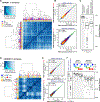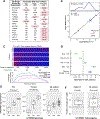Longitudinal RNA-Seq Analysis of the Repeatability of Gene Expression and Splicing in Human Platelets Identifies a Platelet SELP Splice QTL
- PMID: 31852401
- PMCID: PMC7323475
- DOI: 10.1161/CIRCRESAHA.119.315215
Longitudinal RNA-Seq Analysis of the Repeatability of Gene Expression and Splicing in Human Platelets Identifies a Platelet SELP Splice QTL
Abstract
Rationale: Longitudinal studies are required to distinguish within versus between-individual variation and repeatability of gene expression. They are uniquely positioned to decipher genetic signal from environmental noise, with potential application to gene variant and expression studies. However, longitudinal analyses of gene expression in healthy individuals-especially with regards to alternative splicing-are lacking for most primary cell types, including platelets.
Objective: To assess repeatability of gene expression and splicing in platelets and use repeatability to identify novel platelet expression quantitative trait loci (QTLs) and splice QTLs.
Methods and results: We sequenced the transcriptome of platelets isolated repeatedly up to 4 years from healthy individuals. We examined within and between individual variation and repeatability of platelet RNA expression and exon skipping, a readily measured alternative splicing event. We find that platelet gene expression is generally stable between and within-individuals over time-with the exception of a subset of genes enriched for the inflammation gene ontology. We show an enrichment among repeatable genes for associations with heritable traits, including known and novel platelet expression QTLs. Several exon skipping events were also highly repeatable, suggesting heritable patterns of splicing in platelets. One of the most repeatable was exon 14 skipping of SELP. Accordingly, we identify rs6128 as a platelet splice QTL and define an rs6128-dependent association between SELP exon 14 skipping and race. In vitro experiments demonstrate that this single nucleotide variant directly affects exon 14 skipping and changes the ratio of transmembrane versus soluble P-selectin protein production.
Conclusions: We conclude that the platelet transcriptome is generally stable over 4 years. We demonstrate the use of repeatability of gene expression and splicing to identify novel platelet expression QTLs and splice QTLs. rs6128 is a platelet splice QTL that alters SELP exon 14 skipping and soluble versus transmembrane P-selectin protein production.
Keywords: alternative splicing; blood platelets; exons; longitudinal studies; quantitative trait loci; rna-seq; transcriptome.
Conflict of interest statement
DISCLOSURES
The authors declare no conflicts or competing financial interests.
Figures







References
-
- Gnatenko D V, Dunn JJ, McCorkle SR, Weissmann D, Perrotta PL, Bahou WF. Transcript profiling of human platelets using microarray and serial analysis of gene expression. Blood. 2003;101:2285–93. - PubMed
Publication types
MeSH terms
Substances
Grants and funding
- R01 HL141424/HL/NHLBI NIH HHS/United States
- R01 HL118049/HL/NHLBI NIH HHS/United States
- R03 AG040631/AG/NIA NIH HHS/United States
- UL1 TR002538/TR/NCATS NIH HHS/United States
- R01 HL102482/HL/NHLBI NIH HHS/United States
- K23 HL092161/HL/NHLBI NIH HHS/United States
- K01 GM103806/GM/NIGMS NIH HHS/United States
- K01 AG059892/AG/NIA NIH HHS/United States
- I01 CX001696/CX/CSRD VA/United States
- R01 HL144957/HL/NHLBI NIH HHS/United States
- UL1 TR001067/TR/NCATS NIH HHS/United States
- R01 HL066277/HL/NHLBI NIH HHS/United States
- UL1 RR025764/RR/NCRR NIH HHS/United States
- U54 HL112311/HL/NHLBI NIH HHS/United States
- R35 HL145237/HL/NHLBI NIH HHS/United States
- R01 HL142804/HL/NHLBI NIH HHS/United States
- R01 HL126547/HL/NHLBI NIH HHS/United States
LinkOut - more resources
Full Text Sources
Other Literature Sources
Miscellaneous

